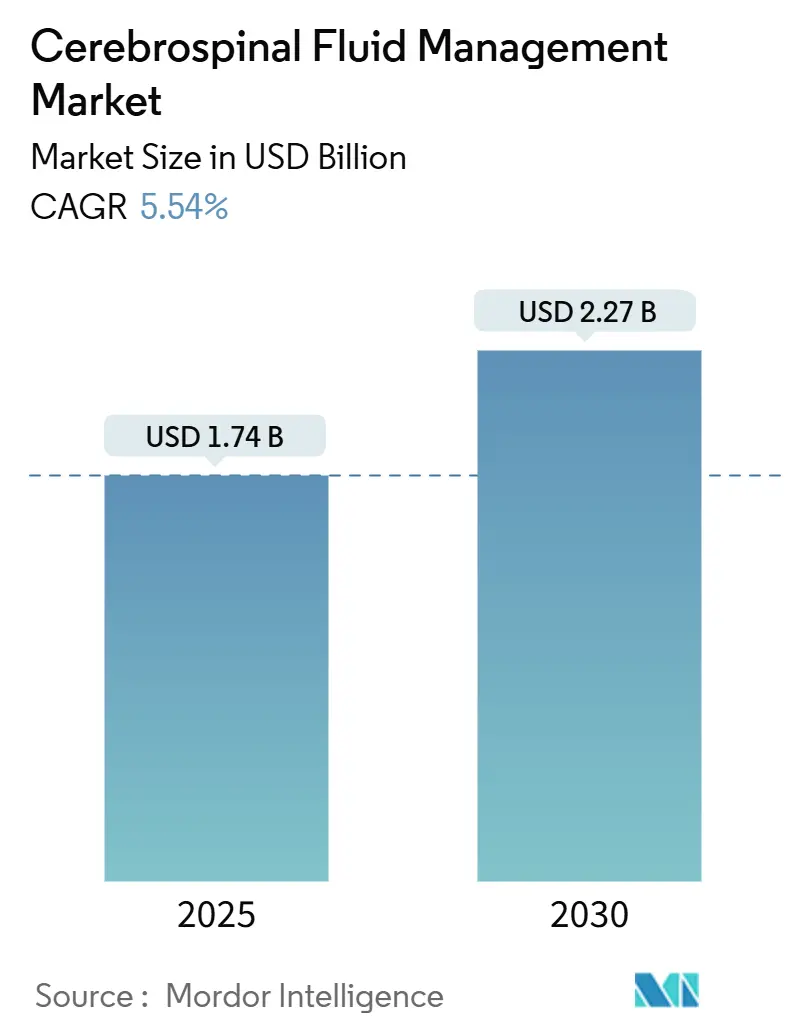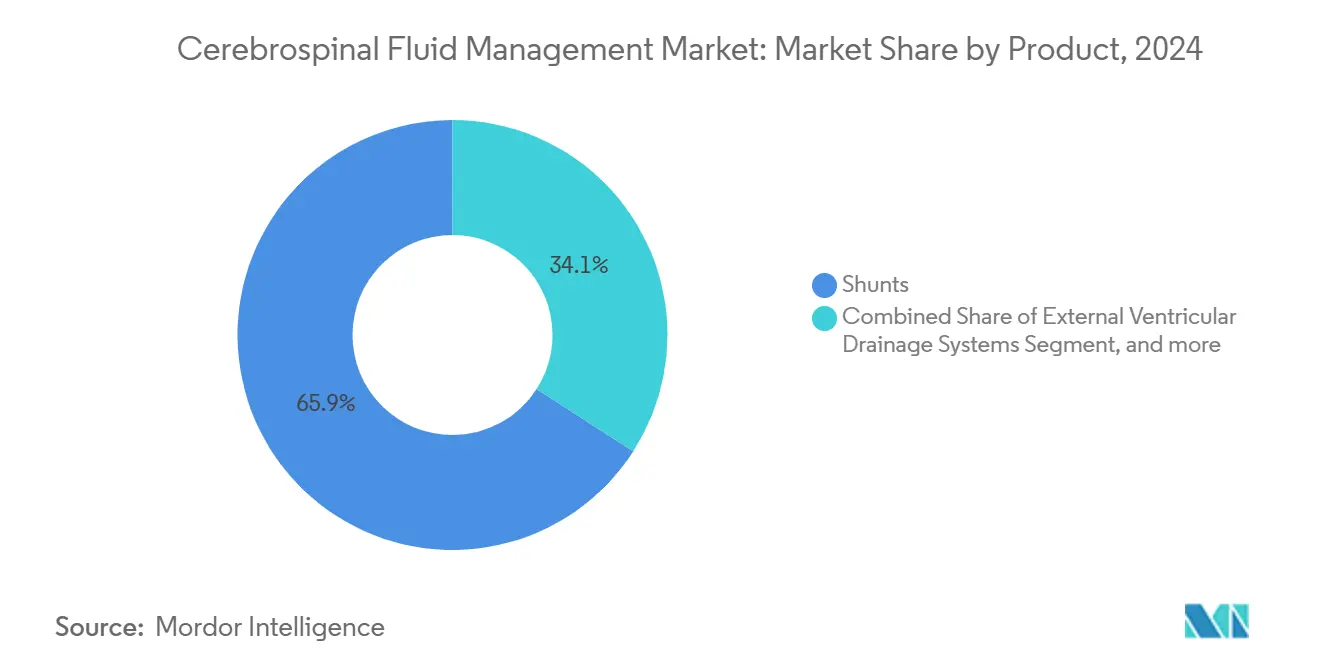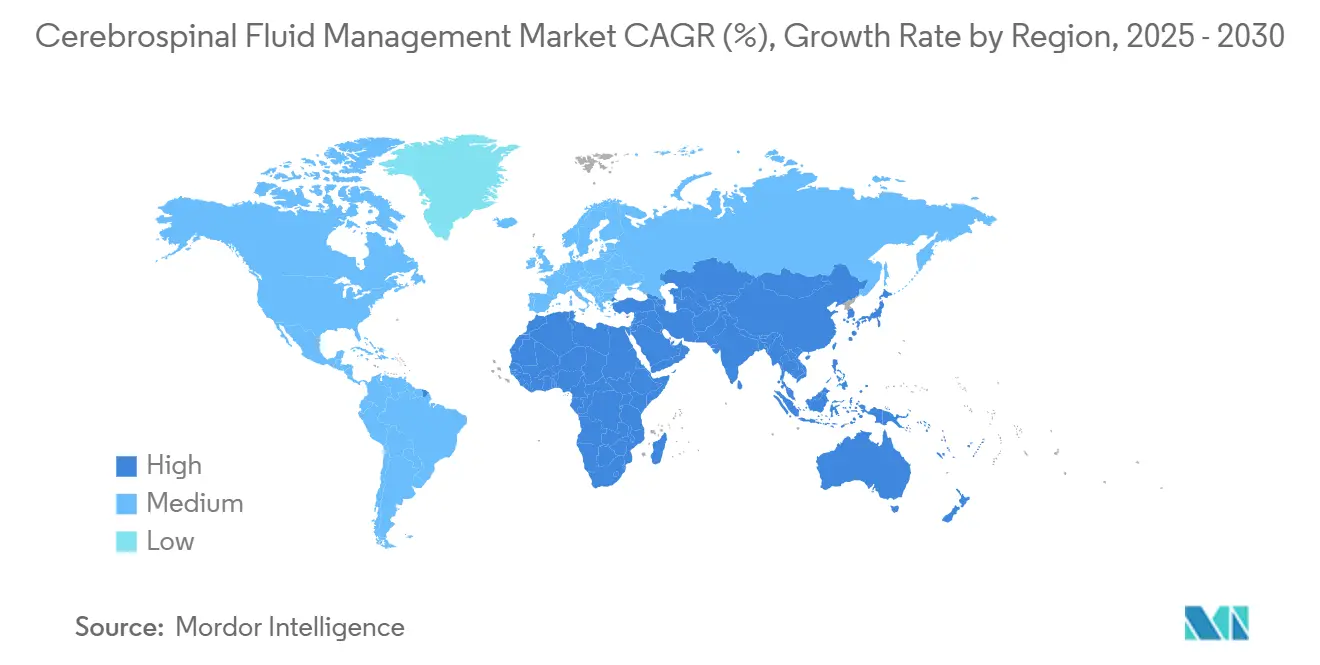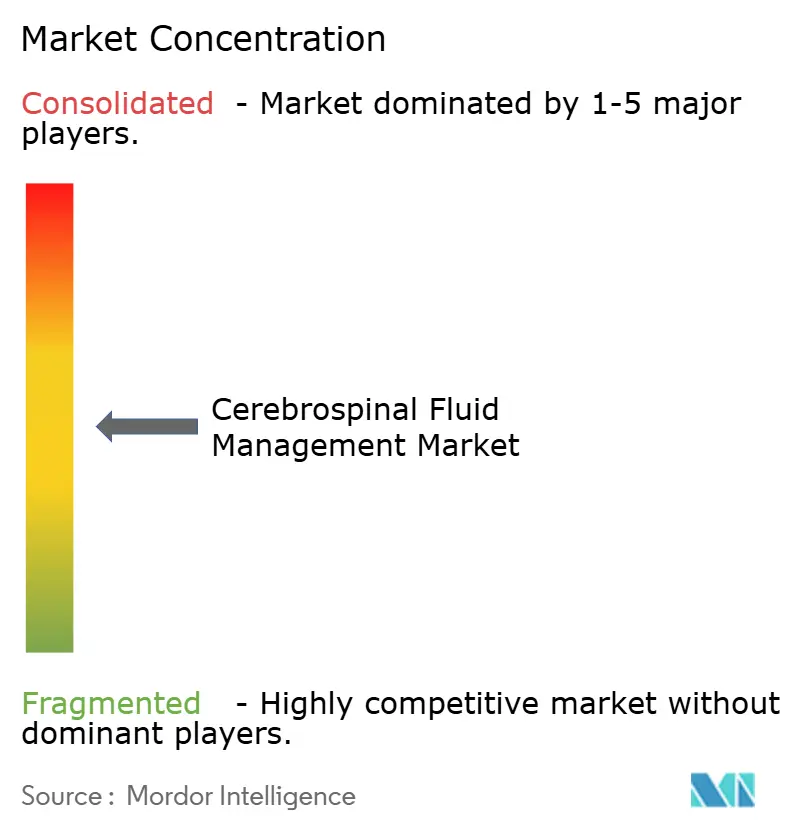Cerebrospinal Fluid Management Market Size and Share

Cerebrospinal Fluid Management Market Analysis by Mordor Intelligence
The Cerebrospinal Fluid Management Market size is estimated at USD 1.74 billion in 2025, and is expected to reach USD 2.27 billion by 2030, at a CAGR of 5.54% during the forecast period (2025-2030).
Demographic aging in high-income economies, rapid uptake of smart programmable shunts, and growing recognition of normal pressure hydrocephalus are reinforcing demand. Hospitals remain the principal treatment venue, yet outpatient facilities are gaining traction as minimally invasive procedures shorten recovery times. Venture funding for endovascular shunt start-ups has accelerated, while FDA breakthrough designations are shortening time-to-market for novel implants. Supply chain fragilities for silicone and rare-earth magnets continue to create intermittent device shortages, motivating OEMs to dual-source components and redesign valves for material flexibility.
Key Report Takeaways
- By product category, shunts led with 65.91% revenue share in 2024; intracranial pressure monitoring devices are forecast to expand at a 7.03% CAGR to 2030.
- By patient age group, the pediatric segment held 51.94% of the cerebrospinal fluid management market share in 2024, while the geriatric segment is projected to post the fastest 7.83% CAGR through 2030.
- By end user, hospitals captured 69.02% share of the cerebrospinal fluid management market size in 2024 and ambulatory surgical centers are advancing at an 8.25% CAGR to 2030.
- By geography, North America accounted for 37.74% of revenue in 2024; Asia-Pacific is set to grow at a 7.41% CAGR between 2025 and 2030.
Global Cerebrospinal Fluid Management Market Trends and Insights
Drivers Impact Analysis
| Driver | (~) % Impact on CAGR Forecast | Geographic Relevance | Impact Timeline |
|---|---|---|---|
| Increasing burden of hydrocephalus & intracranial hypertension | +1.2% | Global, strongest in North America and Europe | Medium term (2-4 years) |
| Growing adoption of minimally invasive neuro-endoscopy & shuntless ETV/CPC | +0.8% | Global, early uptake in high-income countries | Short term (≤2 years) |
| Advances in smart programmable shunts with telemetric ICP monitoring | +1.0% | North America and Europe first, Asia-Pacific next | Medium term (2-4 years) |
| Rising geriatric population susceptible to normal pressure hydrocephalus | +1.4% | Global, most pronounced in developed economies | Long term (≥4 years) |
| Expanding reimbursement for CSF diversion in emerging markets | +0.6% | Asia-Pacific, Latin America, Middle East & Africa | Long term (≥4 years) |
| Emerging endovascular eShunt & ReFlow devices reducing revisions | +0.5% | North America and Europe, spreading worldwide | Medium term (2-4 years) |
| Source: Mordor Intelligence | |||
Increasing Burden of Hydrocephalus & Intracranial Hypertension
Globally, normal pressure hydrocephalus affects 1.5% of people aged 70 years, underscoring a large pool of undiagnosed candidates for intervention. The disease now encompasses glymphatic dysregulation and venous outflow disturbances, pushing clinicians toward multimodal monitoring approaches. In low- and middle-income regions, post-infectious etiologies still account for 10.7% of pediatric cases, creating region-specific product demand.[1]Bradley K. Dlouhy, “ETV/CPC Outcomes in Pediatric Hydrocephalus,” Journal of Neurosurgery: Pediatrics, thejns.org Shunt infections cost a median USD 28,686 per episode, so payers increasingly endorse technologies that cut revision risk. Health systems have expanded screening and multidisciplinary clinics, yet unmet need remains significant, enabling steady expansion of the cerebrospinal fluid management market.
Growing Adoption of Minimally Invasive Neuro-Endoscopy & Shuntless ETV/CPC
Endoscopic third ventriculostomy with choroid plexus cauterization shows 76% 6-month success in multi-center cohorts. Infection rates drop markedly compared with shunting, and dependence on lifelong hardware is eliminated. In post-fetal myelomeningocele repair, ETV/CPC records 17% failure versus 86% for ventriculoperitoneal shunts, extending median time to failure to 17.5 months. Surgeons now leverage HD endoscopes and flexible instruments that broaden the eligible age window, though outcomes still hinge on operator training. With payers rewarding lower revision incidence, demand for endoscopic solutions is rising in the cerebrospinal fluid management market.
Advances in Smart Programmable Shunts with Telemetric ICP Monitoring
Telemetric systems such as the OSAKA telesensor reveal posture-dependent ICP shifts of nearly 20 mmHg, guiding immediate valve re-programming and lowering revision events.[2]Sunil H. Patel, “Intracranial Pressure Patterns With Telemetric Sensors,” Neurosurgery, academic.oup.com FDA breakthrough acknowledgement for the M.scio platform affirms U.S. regulatory support for remote pressure measurement. Gravitational valves like proGAV incorporate Active-Lock features that shield settings from external magnets. Coupled with IoT data pipelines and machine learning, these devices enable predictive maintenance schedules that aim to cut first-year failure from 30% to single digits. Adoption is climbing first in North America and Europe and is expected to accelerate Asia-Pacific growth in the cerebrospinal fluid management market.
Rising Geriatric Population Susceptible to Normal Pressure Hydrocephalus
Germany recorded a 48% jump in normal pressure hydrocephalus diagnoses, reaching 8.0 cases per 100,000 inhabitants. Population studies find a prevalence of 1.5% in 70-year-olds, with male predominance at 2.1%. Median survival after shunt placement stands at 8.82 years, creating durable follow-up demand for shunt adjustments. Specialized clinics and AI-assisted diagnostic panels now accelerate referral pathways, expanding the addressable base. The demographic surge underpins long-term growth in the cerebrospinal fluid management market.
Restraints Impact Analysis
| Restraint | (~) % Impact on CAGR Forecast | Geographic Relevance | Impact Timeline |
|---|---|---|---|
| High revision and failure rates of traditional shunt systems | -1.8% | Global, most acute in lower-resource centers | Short term (≤2 years) |
| Lack of neurosurgical capacity in low-income regions | -1.2% | Sub-Saharan Africa, South Asia, parts of Latin America | Long term (≥4 years) |
| Infection risk associated with external ventricular drainage | -0.7% | Global, higher where infection control is weak | Short term (≤2 years) |
| Supply-chain dependency on silicone and rare-earth magnets | -0.5% | Global, spikes during logistics disruptions | Medium term (2-4 years) |
| Source: Mordor Intelligence | |||
High Revision and Failure Rates of Traditional Shunt Systems
Failure approaches 40% within 12 months, largely due to blockage, infection, or disconnection. One pediatric center reported 31.2% total failures, with revision shunts faring worse than initial procedures.[3]Adele H. Mini, “Shunt Failure Mechanisms in Children,” Child’s Nervous System, link.springer.com Each infection episode costs USD 28,686, and patients undergo an average of 10 lifetime revisions. Antibiotic-impregnated catheters now cut infection from 4.0% to 1.2%, yet mechanical occlusion persists as a dominant issue. ReFlow flushing catheters reduced revisions from 14 down to 1 over 4 years in early cohorts, offering partial relief.
Lack of Neurosurgical Capacity in Low-Income Regions
Africa averages one neurosurgeon per 2.2 million residents, far below the workforce needed for timely hydrocephalus care. Ethiopian data show surgeons clustered in referral hospitals, leaving vast rural zones underserved. Imaging, ICU beds, and sterile theatres are also scarce, compounding access barriers. Nigerian families wait a median of 14 weeks for surgery, with longer delays in lower socioeconomic groups. While low-cost shunts and task-sharing models are emerging, sustainable progress requires investment in training and infrastructure.
Segment Analysis
By Product: Shunts dominate yet innovation pressure mounts
Shunts generated 65.91% of revenue in 2024, underscoring their entrenched role in cerebrospinal fluid diversion. Ventriculoperitoneal models lead volume demand, though adjustable valves are expanding quickest as clinicians prioritize non-surgical pressure tweaks. Intracranial pressure monitoring devices, growing at a 7.03% CAGR, are benefitting from bundled sales with programmable valves, thereby enlarging the overall cerebrospinal fluid management market. External ventricular drains continue as critical tools in trauma and post-infectious cases, supporting a steady accessories business for antibiotic-coated catheters.
Endovascular shunting concepts led by CereVasc aim to shorten hospital stays and enable outpatient implantation, but large-scale adoption hinges on pivotal trial outcomes. Accessories such as flushing adapters are creating preventive maintenance niches and could lengthen device lifecycles. The cerebrospinal fluid management market size for shunt consumables is expected to track the installed base, providing recurring revenue even as next-generation solutions emerge.

Note: Segment shares of all individual segments available upon report purchase
By Patient Age Group: Pediatric holds share, geriatric accelerates
Pediatric cases represented 51.94% of procedures in 2024 as congenital and post-infectious etiologies remained prevalent in low-income settings. The Endoscopic Third Ventriculostomy Success Score guides therapy choice, revealing reduced success under 3 months of age and shaping surgical timing. Meanwhile, the geriatric cohort is growing at 7.83% CAGR, buoyed by rising detection of normal pressure hydrocephalus and improved screening in memory clinics. Adult patients keep a stable share, associated chiefly with trauma and tumor sequelae.
Age impacts hardware selection. Children require growth-adaptable catheters, whereas seniors benefit from programmable and gravitational valves that offset posture changes. Early-life surgery before 40 weeks postconception predicts higher failure, influencing pediatric clinical pathways. Expansion of geriatric indications enlarges the cerebrospinal fluid management market and puts pressure on device makers to tailor products for fragile, multimorbid patients.
By End User: Hospitals command but ASCs gain momentum
Hospitals captured 69.02% of global revenue in 2024 thanks to ICU support, neuro-imaging access, and emergency care readiness. ASC share is growing rapidly at 8.25% CAGR, propelled by payer incentives and minimally invasive workflows. Outpatient pathways are feasible for ETV/CPC and endovascular shunts that average 1.3-day stays versus 3 days for conventional implants.
Specialty neurology clinics absorb diagnostic and follow-up volume, using telemedicine for programmable valve checks. COVID-19 catalyzed migration to lower acuity settings, and digital remote monitoring now underpins this shift. Sustained ASC growth will widen the cerebrospinal fluid management market size across decentralized care sites while hospitals continue handling high-risk revisions.

Note: Segment shares of all individual segments available upon report purchase
Geography Analysis
North America held 37.74% of 2024 revenue on the back of advanced reimbursement frameworks, dense neurosurgical networks, and early uptake of telemetric valves. The United States hosts multiple FDA breakthrough projects, accelerating introduction of next-generation implants and consolidating regional leadership in the cerebrospinal fluid management market. Canada benefits from universal coverage that funds shunt replacements but lags in AI diagnostic adoption.
Europe ranks second, with Germany exhibiting a 48% rise in normal pressure hydrocephalus diagnoses, signaling improved detection rather than incidence shift. National health systems finance programmable valves extensively, though procurement cycles favor multi-year tenders that can slow product refresh rates. United Kingdom centers are piloting outpatient ETV clinics, reinforcing the continent’s tilt toward minimally invasive care.
Asia-Pacific is the fastest-growing region at 7.41% CAGR, driven by China’s hospital expansion and Japan’s rapid aging. Post-infectious hydrocephalus still burdens South and South-East Asia, sustaining demand for low-cost ventriculoperitoneal shunts. Simultaneously, high-income subregions like South Korea procure telemetric valves, broadening the regional cerebrospinal fluid management market. Government capacity-building programs that sponsor fellowship training are gradually reducing surgeon shortages.
Latin America shows moderate progress as Brazilian tertiary centers adopt antibiotic catheters, yet heterogeneous reimbursement limits uniform technology diffusion. Middle East and Africa face acute workforce scarcity, with Central Africa averaging one neurosurgeon per 2.2 million people. International aid missions, public-private partnerships, and low-cost device innovations are vital to expand access. Collective efforts are expected to narrow the treatment gap and spur incremental market growth.

Competitive Landscape
The market is moderately consolidated. Medtronic, B. Braun, and Integra LifeSciences offer full portfolios encompassing programmable valves, gravitational add-ons, and ICP monitors, securing long-term supply contracts with university hospitals. B. Braun’s proGAV line incorporates Active-Lock magnets that resist unintended field exposure, differentiating the firm in the premium programmable segment.
Disruptive entrants are well funded. CereVasc raised USD 70 million in Series B financing in 2024 to advance its endovascular eShunt, targeting patients averse to craniotomy. Quantalx received FDA breakthrough status for Delphi-MD, an AI algorithm predicting shunt responsiveness, underscoring digital diagnostics as a new contest arena. Luciole Medical’s acquisition of Spiegelberg adds pressure sensors and advanced monitoring catheters to its cerebral oximetry line, positioning the firm as an integrated brain monitoring supplier.
Strategic alliances are proliferating. Device manufacturers partner with telehealth platforms to deliver remote valve checkups, while contract manufacturers explore silicone-free catheter materials to mitigate supply shocks. The FDA’s clear Class II pathway under 21 CFR 882.5550 encourages mid-sized OEMs to enter the cerebrospinal fluid management market with niche innovations. Overall rivalry centers on lowering revision rates, minimizing invasiveness, and embedding data connectivity.
Cerebrospinal Fluid Management Industry Leaders
-
Medtronic
-
Integra LifeSciences Holdings Corp.
-
Natus Medical Inc.
-
Sophysa SA
-
B. Braun Melsungen AG
- *Disclaimer: Major Players sorted in no particular order



Recent Industry Developments
- September 2024: Nihon Kohden Corporation acquired 71.4% of NeuroAdvanced Corp., parent company of Ad-Tech Medical Instrument Corporation, for USD 15 million to enhance its intracranial electrode portfolio for epilepsy treatment, expanding its neurosurgical device capabilities.
- August 2024: CereVasc's eShunt System received FDA breakthrough device designation, recognizing its potential to transform hydrocephalus treatment through minimally invasive endovascular approaches.
- May 2024: CereVasc secured USD 70 million in Series B funding to advance its eShunt technology for cerebrospinal fluid management, representing one of the largest investments in hydrocephalus innovation.
- May 2024: The FDA approved CereVasc's STRIDE pivotal study for the eShunt system in normal pressure hydrocephalus treatment, marking a significant regulatory milestone for endovascular shunting technology.
Global Cerebrospinal Fluid Management Market Report Scope
As per the report's scope, cerebrospinal fluid management involves using medical devices such as shunts and external fluid drainage systems to drain excess fluid from the brain.
The cerebrospinal fluid management market is segmented by products (shunts (by valve (adjustable valve shunts, monopressure valve shunts), by type (ventriculoperitoneal shunts, ventriculoatrial shunts, lumboperitoneal shunts, ventriculopleural shunts)), and external vascular drainage devices), and geography (North America, Europe, Asia-Pacific, Middle East and Africa, and South America). The market report also covers the estimated market sizes and trends for 17 countries across major global regions.
The report offers the value (in USD million) for the above segments.
| Shunts | By Valve | Adjustable Valve Shunts |
| Monopressure / Fixed Valve Shunts | ||
| By Type | Ventriculoperitoneal (VP) Shunts | |
| Ventriculoatrial (VA) Shunts | ||
| Lumboperitoneal (LP) Shunts | ||
| Ventriculopleural (VPL) Shunts | ||
| External Ventricular Drainage (EVD) Systems | ||
| Intracranial Pressure (ICP) Monitoring Devices | ||
| Accessories & Consumables | ||
| Pediatric (0-17 yrs) |
| Adult (18-64 yrs) |
| Geriatric (65+ yrs) |
| Hospitals |
| Ambulatory Surgical Centers |
| Specialty Clinics & Neurology Centers |
| North America | United States |
| Canada | |
| Mexico | |
| Europe | Germany |
| United Kingdom | |
| France | |
| Italy | |
| Spain | |
| Rest of Europe | |
| Asia-Pacific | China |
| Japan | |
| India | |
| Australia | |
| South Korea | |
| Rest of Asia-Pacific | |
| Middle East & Africa | GCC |
| South Africa | |
| Rest of Middle East & Africa | |
| South America | Brazil |
| Argentina | |
| Rest of South America |
| By Product | Shunts | By Valve | Adjustable Valve Shunts |
| Monopressure / Fixed Valve Shunts | |||
| By Type | Ventriculoperitoneal (VP) Shunts | ||
| Ventriculoatrial (VA) Shunts | |||
| Lumboperitoneal (LP) Shunts | |||
| Ventriculopleural (VPL) Shunts | |||
| External Ventricular Drainage (EVD) Systems | |||
| Intracranial Pressure (ICP) Monitoring Devices | |||
| Accessories & Consumables | |||
| By Patient Age Group | Pediatric (0-17 yrs) | ||
| Adult (18-64 yrs) | |||
| Geriatric (65+ yrs) | |||
| By End User | Hospitals | ||
| Ambulatory Surgical Centers | |||
| Specialty Clinics & Neurology Centers | |||
| By Geography | North America | United States | |
| Canada | |||
| Mexico | |||
| Europe | Germany | ||
| United Kingdom | |||
| France | |||
| Italy | |||
| Spain | |||
| Rest of Europe | |||
| Asia-Pacific | China | ||
| Japan | |||
| India | |||
| Australia | |||
| South Korea | |||
| Rest of Asia-Pacific | |||
| Middle East & Africa | GCC | ||
| South Africa | |||
| Rest of Middle East & Africa | |||
| South America | Brazil | ||
| Argentina | |||
| Rest of South America | |||


Key Questions Answered in the Report
What is the current size of the cerebrospinal fluid management market?
The market stands at USD 1.74 billion in 2025 and is on track to reach USD 2.27 billion by 2030.
Which product segment is growing the fastest?
Intracranial pressure monitoring devices are projected to advance at a 7.03% CAGR through 2030, outpacing other categories.
How significant is the pediatric patient population?
Children aged 0-17 years account for 51.94% of total procedures, underscoring the segment’s ongoing importance despite growth in geriatric cases.
Why are ambulatory surgical centers gaining share?
Minimally invasive techniques and shorter recovery periods permit suitable patients to undergo treatment in lower-cost outpatient settings, driving an 8.25% CAGR for ASCs.
What technological trends are shaping future growth?
Smart programmable valves with telemetric monitoring, AI-based diagnostic algorithms, and endovascular shunt systems are set to reduce revision rates and expand patient candidacy.
Which region offers the highest growth potential?
Asia-Pacific leads with a forecast 7.41% CAGR due to strengthening healthcare infrastructure and rising awareness of hydrocephalus therapies.
Page last updated on:








